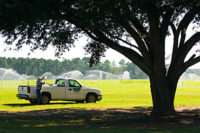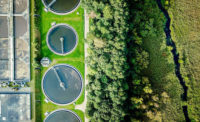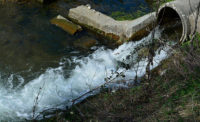Additionally, the biosolids produced from biological wastewater-treatment systems have traditionally been land-applied for their fertilizer and organic matter value. However, with increasing emphasis on nutrient management, i.e. phosphorous soil levels, winter application restrictions, setbacks and buffers, it is becoming more difficult to land-apply in certain watersheds, such as the Chesapeake Bay area, says Jeff Smith, director of corporate environmental services for Perdue Farms.
Scott Hartter, vice president of environment, health and safety at Cargill, agrees that ever-tightening nutrient limitations on permitted discharges into receiving streams pose a significant challenge.
“As states implement their TMDL programs that are required by EPA, we have seen a significant tightening of the total nitrogen and total phosphorus limits at many locations, with more to come in the fairly near future,” he says. “In some instances, the discharge requirements that we must meet for states for total nitrogen and total phosphorus will be well below the required levels for drinking water.”
The majority of processing plants have expended significant capital on upgrading their systems to remove both nitrogen and phosphorus. Lately, the new challenge has been Total Dissolved Solids (TDS), such as chlorides, sodium, magnesium and calcium. Unlike nitrogen and phosphorus, TDS cannot be removed biologically, nor can it be removed through chemical precipitation, says Mark Ritsema, manager of environmental affairs for JBS USA Beef.
“TDS takes non-conventional wastewater equipment to remove, such as reverse osmosis, mechanical evaporation and/or source reduction,” Ritsema says. “Source reduction is a challenge, and the majority of chemicals used to sanitize a processing facility contain minerals that make up TDS. Also, availing the marketability of hides require us to soak them in a brine solution, an extremely high TDS-containing waste stream.”
Insuring food safety also typically results in the use of disinfectants and more water, impacting wastewater treatment operations.
“An overall trend to lower discharge limits requires increased treatment, which results in more wastewater sludge that also needs to be addressed under increasing regulatory requirements,” says Bill Gill, assistant vice president of environmental affairs at Smithfield Foods Inc.
Forward thinking
During the last five years, JBS has spent significant capital on wastewater treatment. The companyhas at least three anaerobic lagoon upgrade projects planned in the next year in order to reduce wastewater strength, produce a robust treatment system and to recover biogas, which will reduce its demand on natural resources.
“JBS recognizes that beneficial reuse of certain byproducts from the wastewater-treatment process exists,” Ritsema says.“Grease is recovered in our pre-treatment steps, resulting in a marketable item. Biogas is recovered in our anaerobic systems, reducing the need for natural resources and greenhouse gas (GHG) emissions. Many of JBS’ facilities have installed the above two items in the past few years.”
Nutrients for fertilizer are recovered throughout JBS’ wastewater-treatment process as well, although this is an area today that typically costs the industry. However, the company believes that these nutrients should, and will someday, be a financial asset, since phosphorus, for instance, is being used at a non-sustainable rate.
Perdue Farms’ Cromwell, Ky., plant takes advantage of a notable advancement in wastewater treatment that other plants have also installed — its anaerobic lagoon has been covered to collect methane.
“Not only does this reduce the plant’s carbon footprint but has resulted in the ability to produce electricity on-site by combusting the captured methane to offset the plant’s electrical demand,” Smith says. “An added benefit has been using waste heat from the electrical generator to enhance the wastewater plant’s performance in the winter months by maintaining optimal temperatures in the system.”
Cargill also made capital investments in its plants to improve its ability to treat nitrogen and phosphorus. In many cases, operating costs also were increased as the company was forced to precipitate phosphorus chemically, which produces more sludge. Additional sludge dewatering capability also has been needed to properly manage the sludge via composting or direct land application as a fertilizer.
“We have capital investment earmarked every year for wastewater improvements and more efficient systems in our plants to achieve water reduction benefits,” Hartter says. “I compare it to swimming upstream: If you stop, you lose ground.”
During the last 10 years, Cargill has institutionalized biogas recovery from its wastewater plants.
“Our first one was installed in 1996 at Fort Morgan, Colo., when natural gas cost was under $1 per 1 million British thermal unit,” Hartter says. “As fuel costs increased and we became more comfortable with the technology, we added biogas recovery at all of the plants that employed an anaerobic system. Today, we have 11 plants that recover biogas, which can represent over 20 percent of the total plant energy needs. It’s pretty cool to think that every fifth animal is processed with renewable energy.”
Smithfield Foods also has several facilities that collect and use biogas generated by wastewater treatment processes to fuel plant boilers. In addition, the company works with suppliers to develop and implement updated monitoring and control systems so wastewater treatment and water use are optimized. Variable-speed drives installed on pumping systems are used to more closely match water supply and demand, conserving both water and energy as well.
“A recent installation of this type for the hot water system at one of our larger plants resulted in an annual water savings of 38.5 million gallons, natural gas savings of 17,320 decatherms, and 209,300 kilowatt-hour in reduced electricity,” Gill says.
Conservation and recycling
To advance water conservation, JBS has established energy teams at each plant with the team’s objective to seek means to reduce water, electrical and thermal energy usages. The teams monitor usage, investigate alternative practices to minimize high-use areas, prepare a task list and set the plan into motion.
“Much success has been realized, reducing water usage by more than 20 percent at some plants,” Ritsema says. “Minimizing water pressure, educating the plant personnel on the reasons why we want to reduce, recycling water used on certain cabinets, availing advance wastewater treatment effluent to wash down non-edible areas of the plant and countless other steps are constantly being operated and installed.”
Perdue Farms is always evaluating cost-effective technologies and management strategies to enhance wastewater treatment as well.
“Quite simply, if it doesn’t go down the drain, it doesn’t have to be treated, so there’s a continuing effort to raise employee awareness to reduce water usage,” Smith says.
For example, rather than hosing down a floor, it can be dry swept. Perdue Farms also operates dissolved-air floatation (DAF) units to remove a portion of the organic load prior to going to the wastewater treatment plant, and recovers fats, oil and grease, which can be sent to a rendering facility instead of being land-applied. The company also captures “front end” water from scalders and chillers that can be re-used elsewhere in the plant for non-critical cleaning of live receiving or feather fluming.
Cargill has made water efficiency a key performance indicator equal to other production performance goals.
“Obviously, measurement is a key, as it is impossible to improve if there is no measurement,” Hartter says. “We’ve focused on that very hard and have resource efficiency teams in our plants that meet weekly to evaluate our water and energy performance. They also identify opportunities and develop actions around technology and process improvements.”
To advance water recycling, Cargill also captures and reuses almost all of the water needed for cleanup at most of its large plants. At a number of its large plants, irrigation on local farm ground provides a great opportunity to reuse all of the water that Cargill uses in its plant.
“Under this scenario, the farmer would have had to pump it out of the ground anyway, so we’ve developed some great partnerships around our plants,” Hartter says. He highly recommends adopting an ISO-based attitude toward resource use in meat-processing plants.
“It is never effective to have just a few individuals in a facility responsible for water or energy usage,” he says. “We have over 2,000 employees in some of our plants that use water every day, and their behaviors will dictate the amount of water used. We educate all of our employees on how we source, heat, chill, use and then treat our water. We also educate them about how much the water they use costs, and regularly ask for reduction opportunities through formalized idea campaigns. It’s amazing how many efficiency improvements we have captured and deployed by taking this participatory approach.”
Smithfield Foods has developed and implemented a Web-based wastewater operator training program to insure its operators are able to address compliance, as well as maximize the capacity and efficiency of its treatment systems.
“Our ISO 14001-certified EMS connects our wastewater operators to plant operations through procedures and regular in-person meetings so that changes in production and/or materials used in the plant can be addressed before they are implemented and potentially impact wastewater operations,” Gill says.
Smithfield Foods has set a goal to reduce water use by 10 percent — normalized over production — by May 1, 2015. The company also implemented an awards program that recognizes projects at its facilities that have a positive environmental impact, including water conservation.
“Projects submitted for our most recent awards cycle included over 219 million gallons per year in water-use reductions,” Gill says.
In regard to water reuse, Smithfield Foods’ Tar Heel, N.C.-facility installed a water reuse system more than 15 years ago that has resulted in water savings of more than 4 billion gallons. Final effluent from the plant also is used for non-contact cooling water in the refrigeration system.
“In many cases across the company, we are able to realize energy as well as water savings by reusing equipment cooling water as boiler feed water,” Gill explains. “In other cases, cooling towers allow us to recycle water for equipment cooling, rather than use a single pass through approach. At some plants we use final wastewater effluent for belt washers on sludge dewatering presses.”
Advanced technologies
New technologies are being introduced constantly to progress wastewater treatment and conservation efforts. Much of this is unproven on a full-scale basis and is therefore met with trepidation. JBS does bench scale some of these novel approaches and, as merited, continues investigating through full-scale application. For instance, with gasification of organic waste streams, the company has gone from trial scale to full scale at one of their facilities.
“The goal of the process is to avail the energy content of the waste stream by recovering the energy in a boiler, reducing natural gas demand and overall GHG emissions in a cost-effective manner,” Ritsema says. In addition, JBS partnered with an outside company to profit from the nutritional content of what was once considered a waste stream.
“At some point in the near future, we believe it is marketable as a feed supplement,” Ritsema says. “Time and effort will tell, but the point is that the industry must continue its efforts to reduce its impact and do so in a cost-effective manner in order to feed the world.”
Filtration systems that operate at a very small scale may eventually prove to be cost-effective in terms of treating wastewater to meet discharge limits as well as reuse requirements, Smithfield Foods’ Gill says. Centralized anaerobic digesters that can accept and combine residuals from smaller facilities and produce energy offer promise too.
“One of our facilities already utilizes such an operation that combines dairy-farm waste with our residuals and other feedstocks to put energy onto the local grid,” Gill says.





Report Abusive Comment